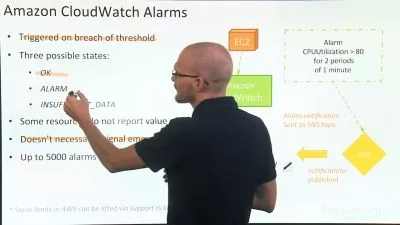Virtual Embedded Linux Board Part 2
Linux Trainer
3:45:30
Description
QEMU, Linux, Boot Linux image on QEMU
What You'll Learn?
- Understanding ARM Ecosystem
- ARM Support in Linux Kernel
- Boot Embedded Linux image for Versatile AB, PB board
- Boot Embedded Linux image for Raspberry Pi3
Who is this for?
What You Need to Know?
More details
DescriptionThis course is second part of Virtual Embedded Linux board, where we will continue our journey with QEMU and have support for more boards
What you will learn as part of this course:
Introduction to ARM Architecture
Differences between ARM Architecture vs Microarchitecture vs core vs SoC vs SBC
Where to look for ARM Documentation
How to check for ARM Linux support
Exploring Code of ARM in Linux kernel (boot, kernel, lib, configs, dts, tools, mm, common,mach-*)
Building and booting Linux images for versatileab platform
Building and booting Linux images for versatilepb platform
Building and booting Linux images for raspberrypi3 platform
Understanding cpuinfo file of proc file system
Building qemu from source code
Building util-linux from source code for packages like lsmem, lsirq, lscpu, fsck
Fixing QEMU errors related to audio and sd card
Generating toolchain for ARMv5TE architecture
Viewing contents of initrd and initramfs using lsinitrd and lsinitramfs
What happens when we run executable compiled for x86_64 on ARM
Loading rootfs from scsi interface on versatilepb board
Booting Raspbian OS on QEMU
Enabling UART and SSH for Raspberry Pi3 target
Building Raspberry Pi Linux Kernel and toolchain
There's no risk either !
This course comes with a 30 day money back guaranteed!. If you are not satisfied with the course, you'll get your money back
So what are you waiting for, enroll now and take the next step in improving your own virtual board
Who this course is for:
- Linux developers who want to have their virtual embedded Linux boaard
This course is second part of Virtual Embedded Linux board, where we will continue our journey with QEMU and have support for more boards
What you will learn as part of this course:
Introduction to ARM Architecture
Differences between ARM Architecture vs Microarchitecture vs core vs SoC vs SBC
Where to look for ARM Documentation
How to check for ARM Linux support
Exploring Code of ARM in Linux kernel (boot, kernel, lib, configs, dts, tools, mm, common,mach-*)
Building and booting Linux images for versatileab platform
Building and booting Linux images for versatilepb platform
Building and booting Linux images for raspberrypi3 platform
Understanding cpuinfo file of proc file system
Building qemu from source code
Building util-linux from source code for packages like lsmem, lsirq, lscpu, fsck
Fixing QEMU errors related to audio and sd card
Generating toolchain for ARMv5TE architecture
Viewing contents of initrd and initramfs using lsinitrd and lsinitramfs
What happens when we run executable compiled for x86_64 on ARM
Loading rootfs from scsi interface on versatilepb board
Booting Raspbian OS on QEMU
Enabling UART and SSH for Raspberry Pi3 target
Building Raspberry Pi Linux Kernel and toolchain
There's no risk either !
This course comes with a 30 day money back guaranteed!. If you are not satisfied with the course, you'll get your money back
So what are you waiting for, enroll now and take the next step in improving your own virtual board
Who this course is for:
- Linux developers who want to have their virtual embedded Linux boaard
User Reviews
Rating
Linux Trainer
Instructor's Courses
Udemy
View courses Udemy- language english
- Training sessions 48
- duration 3:45:30
- English subtitles has
- Release Date 2024/06/14









